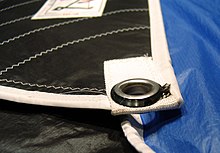Prindle 16 mainsail rides high above the boom
Folks,
Just got Prindle 16('84 vintage) and we rigged it up in back yard and sail looks strange. If I bring sail all the way to the top of the mast so halyard will be engaged on the first catcher there is about 12"-16" clearance to the base of the boom. I can get it down a bit with a downhaul line but it still looks strange. I am new to dinghies and cats - always been sailing keel-boats but wanted to introduce my 14 year old to something faster then our 29" cruiser 🙂
I had tried both mains that came with the boat and they are the same both say P-16 ...
Also would it make sense to remove trapeze while we are no using trapeze yet?
Cheers,
SimDim
Downhauls on a cat are usually directly attached to the mast below the boom or on the gooseneck, if you put it on the mast step or front beam your mast will not be able to rotate. I think the stock downhaul for a Prindle is something like this, Pete correct me. You have 2 cheek blocks attached on either side of the gooseneck. You attach a line to the cringle on the tack of the sail. You run that line down through the first cheek block, back up through the cringle, back down to the second tack ring, back up through the cringle and down to a v cleat on the mast. That will give you 5:1 purchase so you can tension the sail down closer to the boom. Truth is that the Prindle and Nacra sails do tend to sit a little higher than you would likely expect above the boom just because they are loose footed. 6-8" is not unusual especially for a new unstretched (or mylar) sail.
D.
Dave Bonin
1981 Nacra 5.2
Dave,
This makes sense thx. I just looked into manual again and it described the same process - can not figure out how I missed it before (RTFM! again and again 🙄 )
What else I can not figure out is in the manual there is a section on "Mast rotator" and that it has to be installed on the mast. Am I just missing one? Picture show a metal bar that attaches to the boom via a line.
Simon
Also you may want to consider getting a double bullet or micro block with becket and hanging that off of the cringle instead of passing the lines throught he ring. Once you tie to the ring and pass 2 lines through it the rope/rope friction is probably going to be pretty high.
D.
Edited by Wolfman on Jul 23, 2011 - 10:25 AM.
Dave Bonin
1981 Nacra 5.2

A cringle is an eye through which to pass a rope. In nautical settings, the word refers to a small hole anywhere along the edge or in the corner of a sail, rimmed with stranded cordage and worked into the boltrope. Typically it encloses a metal grommet for reinforcement and to reduce wear. In this context, cringle and grommet coincide enough that the two are sometimes used interchangeably.
Had to look up the word "CRINGLE", have not heard that terminology before, so I know there are others who also do not know what a cringle is.
Edited by turbohobo on Jul 24, 2011 - 07:58 AM.
Turbo
On-The-Edge-Of-No-Control
Folks,
Thank you all for the replies. We rigged downhaul just he way Dave described it and it worked really well. There was not much wind on Muskegon lake today but it was just enough for our first taste in cat sailing - I do not think I would give out my 29 footer but this p16 is a blast 😎
Simdim,
When you unroll your mainsail do you notice that the luff (the part that goes into the mast) is kinda curled up? The boltrope inside that luff of the sail shrinks after time and "shortens" up the sail, making it ride higher and harder to downhaul. If this is the case, you will want to cut the stitching that holds the boltrope in on one end and sew a length of rope to the end. Then stretch the sail betwen two trees and use your mainsheet blocks to suck the new line into the luff and sew it shut. You could have a sailmaker do this, but you can do it for the cost of the rope and a saddle stitcher to do the sewing.
Sheet In!
Bob
- 19 Forums
- 8,517 Topics
- 75.8 K Posts
- 0 Online
- 37.7 K Members
